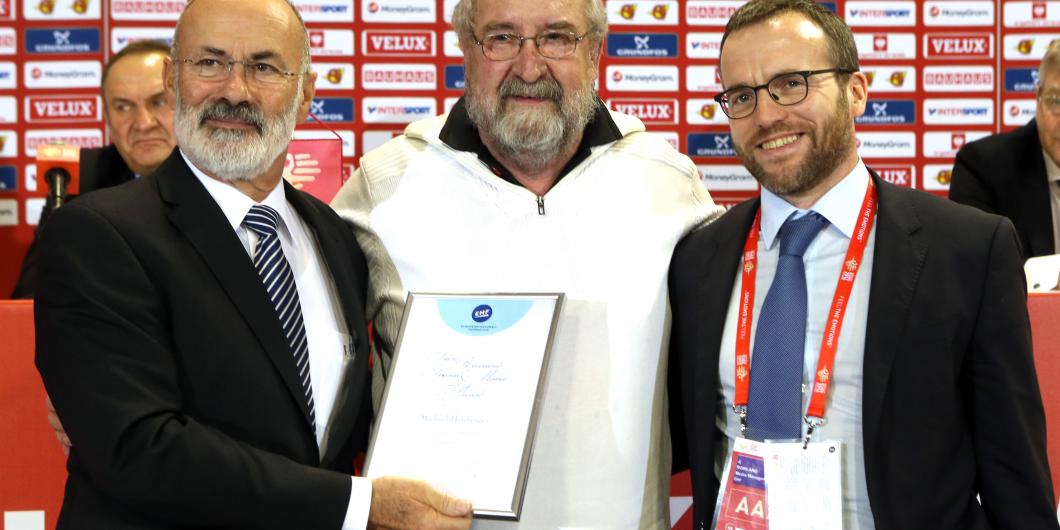He has been a regular feature of international handball for more than a quarter of century. Indeed the photographer, Michael Heuberger, who just turned 70 on 5 October 2016, could be considered an integral part of the EHF’s history. The German photographer has working at all 23(!) EHF EURO events since the start in Portugal in 1994.
Heuberger, who was awarded the “Siân Rowland Special Media Award” in January 2016 in Krakow on the fringes of the EHF EURO 2016 final weekend for his many years of service to the sport, spoke to EHF journalist, Björn Pazen, and takes a look back on the changes to his work as a handball photographer over the past 25 years:
“25 years ago, I was working as a photo retoucher for a huge publishing house, so I had to work on pictures and graphics already, but had been a keen amateur photographer. My ‘handball career’ had started at our local clubs TuS Schutterwald and TuS Hofweier, which in that period had been among the top sides in Germany.
This involvement in handball meant that I had had the chance to photograph international and domestic top players including Peter Quarti, Arnulf Meffle and Oliver Roggisch as well as the German national team coaches, Arno Ehret, Armin Emrich, Simon Schobel and Martin Heuberger and even the Swedish player, Magnus Andersson.
Due to my profession as a retoucher but also due to my own little technical inventions, I had the opportunity to process films on my own and was then asked by several regional newspapers and the national publications “BILD” and Sport-BILD to work for them as a sports photographer.
But to deliver those pictures to the newspapers and magazines was completely different than it is today: The finished pictures for the Sunday editions needed to be carried to the postal train at Offenburg, which departed at exactly midnight, and the photographs had to be posted as express letters. At that time I never expected to become a professional photographer.
In 1994, the European Handball Federation organise the first ever EHF EURO event in Portugal. I went there, mostly to see my idols including the German national team coach Arno Ehret and Magnus Andersson ,both on and off the court.
It was my first handball-related trip to Portugal, but many more would follow, something that I could not have known at the time.
I still have one memory that is as fresh as if it were yesterday. On the morning after Germany had lost a match, I was walking by the River Tajo and saw Ehret sitting there on his own, staring into the water. The only conversation was just “Good morning” - what else could we say after a defeat?
Unfortunately I did not archive those early pictures, I was there at those matches as more as a kind of fan or tourist. You could not imagine today, just turning up at an arena - even at the first ever EHF EURO - with an employee ID card from the little newspaper, Offenburger Tageblatt, to get access as a photographer.
In those early days of the EHF and the EHF EURO, I got to know the EHF President, Staffan Holmqvist, Secretary General, Michael Wiederer, and office staff member Helmut Höritsch. In contrast to today, the EHF did not have any professional media staff, Höritsch helped and supported me a lot. Thus, I became official EHF photographer at some events, just as I did for the IHF.
With the continuous success of the EHF EURO events, digital photography became more popular and affordable for photographers, which meant an enormously quicker availability of the pictures. It was the time when little scanners and modems became part of our work. But still the films needed to be processed in the arenas, sometimes in washrooms, sometimes in empty referee dressing rooms. And still you needed to get connected to a telephone wire somewhere in the arena to transmit your pictures to the news desks.
In the 1990s a fistful of photographers only had been covering big handball matches, but the number rose rapidly when the technical measures became cheaper. At the start of the new century the first digital reflex cameras came onto the market - and with them hundreds more photographers.
With them and the constantly growing media interest in general, the EHF implemented a media department in their office, headed by Siân Rowland, who passed away much too early in 2008. In cooperation with the AIPS, the EHF improved the working conditions of all media at their events and competitions, but especially for us, the photographers.
Besides this, the increasing number of spectators caused new security measures and higher security standards. Together with the rising number of media representatives at handball in general, the guidelines of the accreditation process have changed completely compared to the early years. And: digital photography and the internet have made things much easier for photographers, but also are the reasons for a massive price decline for pictures.”


